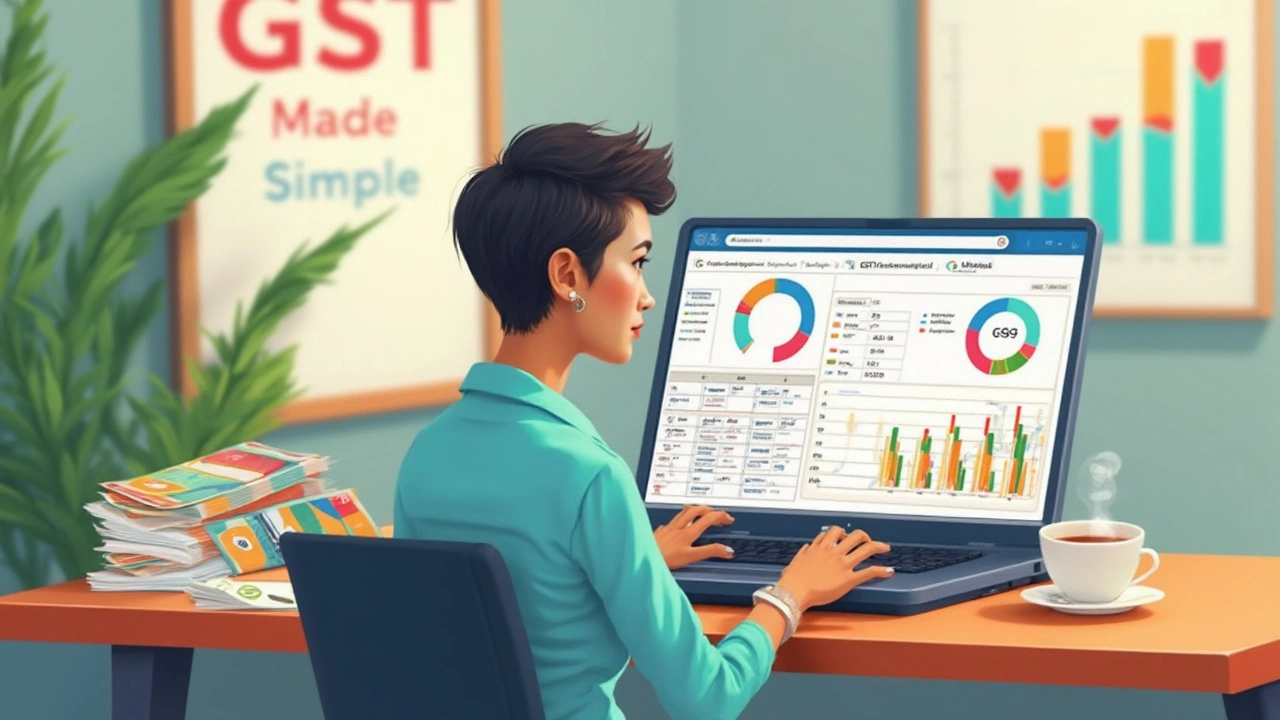
GST is everywhere—restaurant bills, shopping receipts, your Netflix invoice. But when you look at those totals, have you ever wondered exactly how much of that price is the tax, and how much goes to the business? There’s a formula for that, and it’s way simpler than it sounds.
Here’s the deal: the GST formula lets you split out tax from any price. Need to know how much GST to charge your clients? Or maybe you’re filing your GST returns and need to check your numbers? Once you know the exact method, you’ll never second-guess yourself—or get stuck with messy math at billing time.
- Understanding GST and Why It Matters
- The GST Calculation Formula Explained
- GST Calculation Example (With Real Numbers)
- Reverse GST Calculation (When You Know the Total)
- Quick Tips for GST Filing
Understanding GST and Why It Matters
GST stands for Goods and Services Tax. It’s a single, indirect tax that the government charges on just about everything you buy or sell—products, food, digital stuff, you name it. Introduced in India on July 1, 2017, GST replaced a big patchwork of old taxes that used to make business a headache.
Unlike the old days, where taxes hit you at every stage in the supply chain, GST cuts through the mess. Businesses now deal mostly with just one tax instead of VAT, excise duty, and service tax piled on top of each other. This change saves a ton of time and trouble.
“GST has made doing business easier by unifying taxes and reducing compliance burden for businesses of all sizes.” — The Economic Times, July 2022
GST comes with different rate slabs: 0%, 5%, 12%, 18%, and 28%. Most regular stuff, like packaged foods, use the 5% or 12% slab, while luxury goods and certain services fall in the higher 28% category. Nearly everything you use comes with GST rolled in—it’s rarely a separate extra now.
It also matters for compliance. Registered businesses must collect GST from customers, file regular returns, and hand over the tax to the government. Not doing this right can mean late fees or stiff penalties.
Check out how GST makes life easier (and why it’s key to file things right):
- Simplifies tax calculation for businesses
- Reduces double taxation at each supply step
- Improves transparency—everyone sees what tax applies
- Makes claiming input tax credit straightforward
Here’s a quick breakdown showing GST’s reach in India:
| Year | Registered GST Taxpayers (Crores) | GST Collected (Rs. Lakh Crore) |
|---|---|---|
| 2018 | 1.05 | 9.61 |
| 2021 | 1.24 | 11.37 |
| 2024 | 1.46 | 14.85 |
Now, knowing the right GST formula isn’t just a bonus—it’s the rulebook for every business and even a smart shopper. When you understand what’s behind each price tag, GST filing feels way less intimidating.
The GST Calculation Formula Explained
Let’s break down how to use the GST formula so it’s actually useful in real life. You’ll mostly run into two situations: one, you’ve got a price and you need to add GST; or two, you already have a total (which includes GST) and you want to know what part is just the tax.
If you want to add GST to a price (say, a product costing ₹1,000 and GST is 18%):
- GST Amount = (Original Price × GST Rate) ÷ 100
- Total Price including GST = Original Price + GST Amount
So for a ₹1,000 item with an 18% GST rate:
- GST Amount = (1,000 × 18) ÷ 100 = ₹180
- Total Price = 1,000 + 180 = ₹1,180
But what if you already have the total price and want to figure out the GST part? Here’s what you do:
- GST Amount = Total Price × GST Rate ÷ (100 + GST Rate)
Still using ₹1,180 (where GST is 18%):
- GST Amount = 1,180 × 18 ÷ 118 = ₹180
This formula is super handy while invoicing, filing returns, or checking bills for accuracy. GST always gets rounded off to the nearest rupee in practice, just in case your math returns decimals.

GST Calculation Example (With Real Numbers)
Let’s make this whole GST formula thing super clear. Imagine you’re selling a gadget for ₹2,000, and the GST rate is 18%. What’s the tax? And what’s the final bill your customer forks over? Here’s exactly how that breaks down.
The standard GST formula is pretty simple:
- GST Amount = (Original Price × GST Rate) / 100
- Final Price = Original Price + GST Amount
Stick with the gadget example. Here’s the math:
- Original Price: ₹2,000
- GST Rate: 18%
- GST Amount: (2,000 × 18) / 100 = ₹360
- Final Price: 2,000 + 360 = ₹2,360
It’s that direct. Now, if you already have the total amount (inclusive of GST) and want to pull out just the GST part, use this formula instead:
- GST Amount = Total Amount × GST Rate / (100 + GST Rate)
So, say a bill reads ₹2,360 (GST included), and GST is 18%. Here’s what you do:
- GST Amount = 2,360 × 18 / 118 = ₹360
- Base Price (before GST) = ₹2,360 - ₹360 = ₹2,000
To make things even clearer, here’s a quick reference table so you can see how prices change with different GST rates for that ₹2,000 gadget:
| GST Rate | GST Amount (₹) | Final Price (₹) |
|---|---|---|
| 5% | 100 | 2,100 |
| 12% | 240 | 2,240 |
| 18% | 360 | 2,360 |
| 28% | 560 | 2,560 |
Most everyday goods in India fall between the 5% to 18% GST slabs. Stuff like electronics sits at 18%, while essentials like food grains are often zero-rated. If you start using these formulas for your invoices or expense tracking, you’ll never get caught off guard by tax calculations again.
Reverse GST Calculation (When You Know the Total)
Ever get a bill with just a grand total and wonder what actual amount is for goods or services—and how much is just GST? You’re not alone. Sometimes, businesses or freelancers need to pull out the GST from a tax-inclusive price, especially when prepping for filing. Here’s the easy way to do it without messing things up.
The main trick: use the GST formula for reverse calculation. If you know the total price (which already includes GST) and the GST rate, you split out the portions using a simple formula:
- Base Price = Total Amount / (1 + GST rate/100)
- GST Amount = Total Amount - Base Price
Let’s make it crystal clear with an example. Say you bought a laptop for ₹59,000. The price includes 18% GST. What’s the base price and how much GST did you really pay?
- Divide the total amount by 1.18: ₹59,000 / 1.18 = ₹50,000 (Base Price)
- Subtract the base price from the total to get GST: ₹59,000 - ₹50,000 = ₹9,000 (GST)
Quick cheat-sheet for common GST rates is super handy. Here’s a table you can use for fast math:
| GST Rate | Divide By |
|---|---|
| 5% | 1.05 |
| 12% | 1.12 |
| 18% | 1.18 |
| 28% | 1.28 |
One tip that saves time: keep these numbers nearby or on your phone. And remember, reverse GST calculation is a lifesaver if you’re a freelancer, trader, or anyone who deals with mixed-up bills when it’s filing season. No more guessing. No more errors on your returns.

Quick Tips for GST Filing
Messed up GST filing can trigger penalties and plenty of headaches. Good news: you can avoid most issues with a few practical habits. Here’s what actually helps when you’ve got to file GST returns in India.
- GST formula mastery: Keep your calculation process simple. Use the correct formula for every invoice, whether you’re adding GST or pulling it out of a total. Checking with a calculator or an Excel sheet before filing never hurts.
- Don’t miss deadlines: The due date for regular GST returns (GSTR-3B) is usually the 20th of every month, but sometimes it changes. Always double-check official updates, especially around holidays or financial year end.
- Don’t ignore the details: Double-check GSTINs (your customer’s and your own), invoice dates, and tax breakdowns. Something as basic as a typo in the GST number can make your return bounce back, or worse, get you a fine.
- Keep your documents safe: The GST department can ask for supporting docs—bills, contracts, payment proof—up to six years later. Storing digital copies saves a ton of stress if you get an audit notice down the line.
- Claim your credits: Input tax credit is money you get back on business expenses—make sure you’ve got the right purchase invoices and that your vendors have actually filed their returns. Forget to check, and the credit could be denied.
If you’re ever lost, the government’s GST portal (www.gst.gov.in) has help files and video guides that actually make sense. And if things still seem fuzzy, it’s worth talking to a CA or GST pro. It’s cheaper to get help up front than sort out mistakes after the fact.








Write a comment